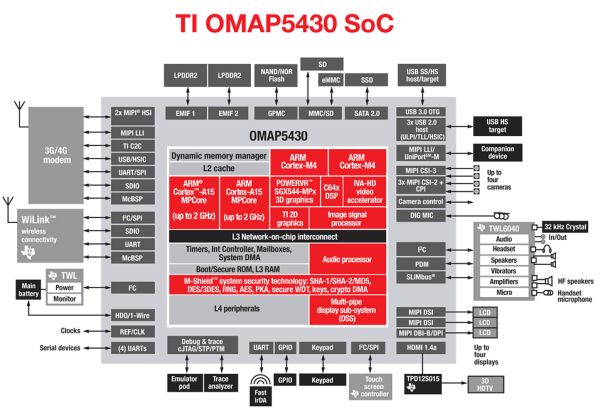TI Reveals OMAP 5: The First ARM Cortex A15 SoC
by Anand Lal Shimpi on February 7, 2011 8:59 PM EST- Posted in
- Smartphones
- OMAP
- Arm
- TI
- Cortex A15
- Mobile
- SoCs
TI sure does have impeccable timing. Not 12 hours after we published our LG Optimus 2X and NVIDIA Tegra 2 review, complete with a discussion of the 2011 SoC space, did TI announce its OMAP 5 SoC.
OMAP 5 will go into production in the second half of 2011 and ship in phones during the second half of 2012. It’s a 28nm SoC with significant architectural upgrades compared to the OMAP 4.
While the OMAP 4 integrates a pair of ARM Cortex A9 cores, OMAP 5 features two ARM Cortex A15 cores. TI already announced that it was ARM’s first licensee of the Cortex A15, so the OMAP 5 announcement is not too surprising.
The ARM Cortex A15 cores can run at speeds of up to 2GHz, although specific frequencies will depend on the OEM implementation. At 2GHz TI claims the pair of Cortex A15s should be 3x the speed of the 1GHz Cortex A9s in the OMAP 4330. At the same clock speed, TI is boasting a 50% performance advantage from the A15 over the A9.
With the OMAP 3 TI had a 256KB L2 used by its single Cortex A8. The OMAP 4 quadrupled L2 cache size to 1MB and shared it among both of its Cortex A9s. TI’s OMAP 5 doubles L2 cache size to 2MB, operating at the CPU clock speed, and it’s once again shared by the SoC’s two CPU cores (in this case Cortex A15s). The OMAP 5 retains the same dual-channel LPDDR2 memory interface from the OMAP 4.
Architecturally we still don’t know much about what makes up a Cortex A15, although I suspect we’ll get more of that in the coming months. Update: It looks like ARM has released some info on the A15. It appears to be a wider, deeper, even more OoO architecture. More on this later.
In our Tegra 2 review I mentioned that the transition from ARM11, to Cortex A8 and now to Cortex A9 left us with a generational performance improvement each step of the way. The move to A15 will be no different. ARM’s Cortex A8 went mainstream in the performance segment in 2010, Cortex A9 will do the same in 2011 and with any luck we’ll see A15 before the end of 2012. It’s this sort of yearly cadence that ARM and its partners must keep up in order to really catch up and surpass what Intel has been promising with Atom. Atom came out in 2008 and it won’t be until late 2012 that its architecture is truly refreshed. For a company that survived the mistakes of NetBurst, Intel doesn’t seem to have learned much of a lesson there.
In addition to its dual Cortex A15 CPUs, the OMAP 5 will feature two ARM Cortex M4 cores as well. The M4 isn’t very useful as a general purpose microprocessor, it only supports the ARM Thumb/Thumb-2 instruction sets (not the full 32-bit ARMv7-A ISA). The M4 does have a suite of signal processing extensions that can be used to accelerate audio/video encode and decode. One application of the M4s will be still picture enhancement. A goal for the next-generation of SoCs is to begin to bridge the gap between smartphone camera quality and high-end point-and-shoot and DSLR cameras. Obviously we’ll always be bound by the poor optics possible on smartphones, however there’s still a lot that can be done in hardware to improve the quality of what’s captured.
The OMAP 5 supports up to four cameras. One demo I saw Intel put together a while ago was of a smartphone with two equal resolution/quality cameras on its back. The only difference between the two was the focal length of the lens. Whenever you took a photo with the demo camera you’d actually capture the scene at two (vastly) different focal lengths. The SoC (in this case an Atom) would use the captured data to produce one image where the entire scene was in focus, with improved sharpness/detail over a single camera solution. It’s possible that OMAP 5 based smartphones may feature similar technologies and use its Cortex M4s to merge/interpolate data from the camera sensors.
As ARM’s CPUs grow in power consumption, the amount of fixed function or specialized silicon set aside to offload various tasks will increase. The Cortex A15s should be used only for those applications that absolutely need them, anything else should be offloaded.
The OMAP 5 SoC integrates Imagination Technologies’ PowerVR SGX 544 GPU, although it’s unclear how many cores will be present in TI’s implementation. Each SGX 544 core has four USSE2 pipes compared to four USSE pipes in the SGX 540, and two USSE pipes in the SGX 530. Each USSE2 pipe offers an increase in compute power compared to the old USSE pipes, however I don’t have details on specific differences in internal organization.
TI announced two versions of the OMAP 5: the 5430 and 5432. The OMAP 5430 features a 14 x 14mm PoP with LPDDR2 memory support, while the 5432 is a larger 17 x 17mm BGA package with DDR3/DDR3L support. The 5430 will likely be used in smartphones while the 5432’s larger size would be better suited for tablets.
On paper alone the OMAP 5 looks to be very powerful, but it needs to be. Also shipping in 2012 will be Qualcomm’s MSM8960 and we may see Project Denver as well. The application processor race hasn’t even begun to heat up, but it’s starting to get interesting.












39 Comments
View All Comments
MobiusStrip - Tuesday, February 8, 2011 - link
"50 years ago, did people spend $100 a month on cable?"They didn't do that 20 years ago. You're just being complacent because you feel helpless. We are now burdened with so many such people that companies are free to ream consumers almost without bounds.
Fifty years ago, nobody would've predicted that customers would not only endure, but make excuses for the kind of treatment they get today.
"Sir, you can buy this record, but you can only play it in your living room and not your bedroom. You also can't take it to your friend's house or give it to your kids. And it doesn't come with a cover. And if you play it loud enough for the neighbors to hear, we will sue you."
"Yes sir, this car is the latest model. See the bumpers, the part that's supposed to sustain occasional contact with other cars or objects? We've covered them with glossy paint!"
"Sir, you must pay us for this band saw, but you're not actually buying it. You're only paying for a license to use it. If you try to sell it at a garage sale, we will sue you."
Yeah, things are just hunky dory now.
Alexvrb - Wednesday, February 9, 2011 - link
After reading Shadow's comments, and then yours, I have come to an inescapable conclusion:You both enjoy preaching from soapboxes, but yours is taller than Shadow's.
synaesthetic - Tuesday, February 8, 2011 - link
u madU MAD
sup troll?
Akv - Tuesday, February 8, 2011 - link
Thank you. That is exactly what I think. I don't care about the next thingy with touchable icons.I want real productive stuff, in order to read, write, create....
For example last month I bought a basic phone and a large 27" monitor with LED lighting and better colors. The present focus on little gadgets is boring.
Your phrase "spiritually devoid" is excellent and insightful.
vol7ron - Monday, February 7, 2011 - link
I'm more worried about the power consumption. 2GHz is up there, this sounds more like a competition for Brazos.Wilco1 - Tuesday, February 8, 2011 - link
A 2GHz Cortex-A9 uses ~1W on 40nm. At 28nm, Cortex-A15 should be similar. Brazos is slower and still uses ~10x more power. Competition? Not really...metafor - Tuesday, February 8, 2011 - link
I don't know about the estimates of A15 at 28nm. The micro-architecture is huge. I would seriously doubt -- even if 28nm offered a 50% power reduction, it'd maintain the same power envelope as an equivalent frequency A9.Wilco1 - Tuesday, February 8, 2011 - link
If you compared a power optimized A9 vs A15 on the same process then yes, the A15 would use a lot more power as it is more complex.However the 2GHz A9 is a highly optimized part and uses almost twice as much power as a standard A9. The A15 has a much deeper pipeline and scales well beyond 2GHz. Therefore it doesn't need to be as optimized and thus lose as much power efficiency as the A9 to reach 2GHz. So it's more than just process scaling.
metafor - Tuesday, February 8, 2011 - link
I believe there will be a power optimized A15 as well running "up to" 1.5GHz from ARM (other vendors will do the backend work themselves of course).I expect even that to be more power hungry at similar frequencies to, say, a 1.5GHz A9. Now, the performance increase may merit that extra power draw, but the overall power usage would likely be higher.
In the tablet space, it seems like an incredibly suited device. In a phone....not so much.
Wilco1 - Wednesday, February 9, 2011 - link
If all else is equal, the A15 will use more power than the A9 at the same frequency. But it can power down sooner when performing the same tasks as it is much faster. How much this affects overall power use depends on how often you actually need the extra performance.The only info I've seen from ARM claims that for a given task, a dual core 32nm A15 uses less than half the energy of a single core 65nm A8. Assuming 30% power reduction per process step means the A15 is as efficient as an A8. So I think it is too soon to say the A15 is unsuitable for a mobile.